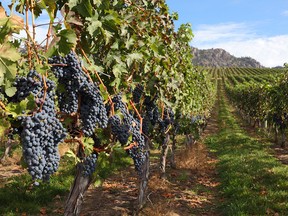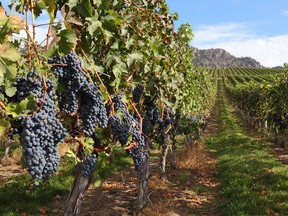Reviews and recommendations are unbiased and products are independently selected. Postmedia may earn an affiliate commission from purchases made through links on this page.
Okanagan winemakers Bartier Bros. pivot after devastating season

Now you know what it means when wine people say that when the glamour of the tasting room is closed, the wine business is mostly farming.

Article content
Michael Bartier, co-owner and winemaker at Bartier Bros. Vineyard and Winery on the Black Sage Bench, recently shared the challenges he and his team are facing in the vineyards and the winery after two devastating cold winter nights, one in 2022 and one in 2024, and what it means for the future.
At 5 a.m. on Dec. 22, 2022, he was in the vineyard “trying to get the wind machines started, to hopefully mix up a temperature inversion. At -24 C, our machines’ propane was on the verge of being liquid; the carburetors kept flooding. We finally got them started, and the temperature went from -24 C to -24 C — there was no inversion.”
Advertisement 2
Article content
Eight days later, Bartier examined bud dissections from his blocks with legendary Okanagan growers Rob Cleave and Lanny Martiniuk.
“None of us believed what we were seeing: zero per cent viable primary buds, and only a few blocks with noticeable secondary and tertiary buds that were viable.”
By the summer of 2023, it was clear he had lost all Syrah vines, and the Merlot, Semillon and Cabernet Franc vines were severely damaged. He quickly pulled the Syrah and replanted that block to Cabernet Franc, abandoning the Merlot to be replanted in 2024 on its roots for better protection against the cold.
He farmed the Semillon to one ton per acre, but it, too, would need to be replanted in 2024. He committed to remediating the established Cabernet Franc vines, encouraging new sucker growth from low on the trunks so that he could retrain new trunks.
The bright light was Chardonnay, a star absorbing the cold and “still yielding a two-ton-per-acre and good shoot growth. We anticipated these would recover fully by 2024.”
The bottom line was an overall 2022 crop size that was 25 per cent of normal.
Advertisement 3
Article content
The January 2024 cold damage was a gut punch, and it was “far worse than the previous winter, with temperatures hitting -25 C at our vineyard and considerably colder elsewhere.”
The result: “The Cabernet Franc established vines were hit hard again. Early indications are that we’ll likely need to pull out this block. The young Cabernet Franc vines planted last spring did not survive at all. These will all be pulled out. The Chardonnay block on rootstock is badly damaged, and we’ll need to be pulled out.”
There was some moderately good news.
“The Chardonnay block planted on its own roots has excellent growth from sucker shoots at ground level. We will retrain these shoots to form new trunks and cordons. We anticipate to be back in full production for vintage 2025.”
The Merlot block damaged the previous winter has been replanted to Merlot vines on its own roots.
The Semillon block damaged last winter was replanted, partly on rootstock and partly on its own roots.
Bartier experimented with burying canes over the winter of 2024 and plans to adopt the practice in all his vineyards starting this fall.
Article content
Advertisement 4
Article content
“If we experience a mild winter, we only need to reveal the canes, prune them back to two buds, and then let these buds grow again that season so that we can repeat this the following winter. If we experience a harsh winter, then we’ve insured ourselves.”
With three lean years ahead, Bartier will rely on his contracting business to get through the shortage of grapes and wines to sell.
“We’re good at what we do, and we’re efficient. We’ve been making wines for other wineries for several years now. It’s been a win-win for all; they’ve received good winemaking in a well-equipped facility and helped us pay for that equipment. We’ve expanded this model to the vineyards now as well. Farming at a larger scale has enormous benefits for quality and economics. It’s allowing us to invest in good equipment and people.”
Much of this narrative is the same across B.C. wine country this summer.
Now you know what it means when wine people say that when the glamour of the tasting room is closed, the wine business is mostly farming.
Weekend Wine Picks

Bartier Bros. Brut N/V, Oliver, Okanagan Valley, British Columbia, Canada
Advertisement 5
Article content
$34.99 I 90/100
UPC: N/A
The longer this multi-vintage sparkler remains in the bottle, the better it gets. It is another year down the road, and it has added its charm, pitching more complexity and length. Central to that success is the traditional-method production program, which has gone multi-vintage, using a small supply of reserve wines to stabilize a true house style. Green apples with juicy citrus electrify a peach and pear underside with creamy, toasty notes. I love the taut, linear lines and lemon peel finish. Oysters, anyone? Friendly, fresh, and a lovely work in progress.

Bartier Bros. Chardonnay 2023, Oliver, Okanagan Valley, British Columbia, Canada
$24.99 I 89/100
UPC: 628055147169
Cerqueira Vineyard sits on the Black Sage Terrace in Oliver and is the source of this Chardonnay. Its sandy loam topsoil on mainly granite glacial till contains high amounts of calcium sulphate precipitates that add energy and minerality to a tightly strung, modern Chardonnay. The wine sees no oak and is aged for only four months in stainless steel. Its creamy textures mitigate the crunchy pear, green apple, and saline lemon finish on what is a marvellous food wine. Shellfish, whitefish, chicken salads and the like all work here.
Advertisement 6
Article content

Bartier Bros. Rosé 2023, Okanagan Valley, British Columbia, Canada
$19.99 I 88/100
UPC: 628055147312
The ’23 is barely pink, likely because no red grapes are involved in the recipe. The latest is made from 56 per cent Gewürztraminer from Summerland, while the Black Sage Bench Terrace is responsible for 24 per cent Chardonnay, 10 per cent Pinot Gris, eight per cent Kerner, and two per cent Viognier. The style is Bartier super clean and spare with zero lees contact. The flavour runs to citrus fruits with a pinch of rose petals on the nose. Light, refreshing, quaffable and dry, it is the essence of the Terrace, with trace minerals to guide you through the finish.

Bartier Bros. Granite 2021, British Columbia, Canada
$25.99 I 89/100
UPC: 6280551474004
The Granite Red Blend is a 53/32/12/3 mix of Syrah (Black Sage Terrace), Merlot (Golden Mile Bench), Cabernet Franc (Cawston), and Cabernet Sauvignon (Cawston). It is hand-harvested, destemmed, and crushed into five-ton open-top fermenters, spending 23 to 27 days on skins. It is aged 19 months in 225-litre neutral French barrels that leave the fruit fresh, round, and whole. Lovely weight here, a bit of heat, but a delicious red made for the dinner table. Acceptable value, too.
Advertisement 7
Article content

Bartier Bros. Merlot Cerqueira Vineyard 2022, Oliver, Okanagan Valley, British Columbia, Canada
$25.99 I 89/100
UPC: 628055147114
The 2022 Merlot from Cerqueira Vineyard is grown on the Black Sage Terrace in Oliver over sandy loam topsoil on mainly granite glacial till. Post stainless steel, it lasts 15 months in 225L neutral French barrels. This style differs entirely from what you usually encounter in the South Okanagan. Look for a higher mineral presence, refreshing blue fruits, wet stones, and fresh but supple tannins.
Wine of the Week

Le Vieux Pin Vaïla Rosé 2023, Okanagan Valley, British Columbia, Canada
$24.99 I 91/100
UPC: 808755017485
2023 yields were low due to winter conditions, but wine grower Severine Pinte believes it was an excellent year for Pinot Noir and rosé. This all-Pinot pink is exclusively aged in stainless steel, yielding deliciously full-flavoured notes of rhubarb, grapefruit, minerals, and wild strawberries. It’s serious enough for a dinner table and fun enough for lingering on the patio with hand-passed appetizers. The winery suggests pairing it with a tossed baby-greens salad, fresh berries, and warm vegan cultured cheese on a summer day.
Advertisement 8
Article content
Calendar items
Grizzli Winery is holding its annual Outdoor Cinema Series on Sept. 13, 14, 20, 21, 27 and 28, featuring a diverse offering of movies, from classics to Rom-Coms to family-friendly films. It is a one-of-a-kind theatre experience in the vineyards. They cover everything you need for a perfect movie night, including lounge-style chairs and a concession stand. The outdoor bar serves a wide selection of wine, beer, cider, and non-alcoholic options. The concession stand will offer fresh popcorn, savoury pretzels, chips, sweets, and more. There are also hot vineyard appetizers you can order from the bar made fresh on-site from 31 Charkay and delivered to your seat. Doors open at 7 p.m.; Tickets are $10 and movies start at sundown. More info can be found at www.grizzliwinery.com or by calling 250-769-6789.
***
Visit Napa Valley sponsors an in-market survey to gather visitor information and assess the economic impact of tourism within Napa Valley. In 2023, Napa Valley welcomed 3.7 million visitors. The tourism industry generated $107.5 million in tax revenue for local resident services, up 26 per cent from 2018. Visitors to Napa Valley spent $2.5 billion supporting local businesses. Almost 70 per cent is generated from overnight hotel guests. The average visitor spent $281 in Napa County per day. Direct visitor spending within the county increased by 13 per cent since 2018. The tourism industry remains the second largest employer in Napa County (after the wine industry), supporting an estimated 16,000 jobs in the community. Of particular interest: the average age of the Napa Valley visitor is 40, six years younger than the 2018 average of 46. Visitor spending per day in Napa Valley is $7 million on average.
Advertisement 9
Article content
Value Wine of the Week

Pour Le Vin Faim de Loup Syrah 2022, France
$19.99 I 89/100
UPC: 3430560010923
Pour Le Vin Faim de Loup Syrah is a delicious red from France’s IGP Pays d’Oc region. Syrah can be a big wine in the Northern Rhone, but this red made from 40-year-old vines is juicy, slippery, fruity, and peppery all in one, and it slips down easily. Could this be the best-value Syrah wine under $20 sold in British Columbia? I would be happy to taste any wines that come close to it, but my guess is there are very few, if any, to be had. Boutinot, France, produces the wine, and the grapes are sourced from southwest Languedoc. “Faim de Loup” translates to “hungry like a wolf,” the perfect moniker for a wine designed for southern France’s rich stews and casseroles.
Recommended from Editorial
Bookmark our website and support our journalism: Don’t miss the news you need to know — add VancouverSun.com and TheProvince.com to your bookmarks and sign up for our newsletters here.
You can also support our journalism by becoming a digital subscriber: For just $14 a month, you can get unlimited access to The Vancouver Sun, The Province, National Post and 13 other Canadian news sites. Support us by subscribing today: The Vancouver Sun | The Province.
Article content
Source: vancouversun.com



